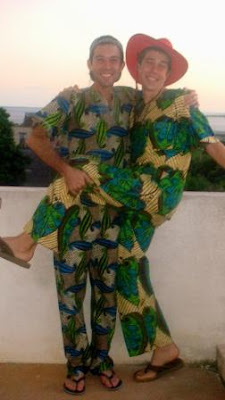 Photo by Ausi Petrelius
Photo by Ausi PetreliusTo fully express with authority the wonders of the capulana, I would like to borrow some words from the heart of a Mozambican writer, Paulina Chiziane, who recently featured an article about capulanas in the nation's most prestegious magazine. Of the capulana, she writes:
"It accompanies all the stages of our life. With it, we recieve the new-born infant; with it, we make attire for all ages; it is shroud, sheet, headscarf, and blanket. With it, we tie the baby to our back, or make a bundle of vegetables, or tie up a bunch of firewood. It's the practical funcion which gives this strip of cloth is very peculiar character. The capulana is the symbol of Mozambican women, of African women. A real Mozambican woman must have a capulana. Two capulanas. A thousand capulanas or more--the number doesn't matter. One capulana is never the same as another. There can never be too many."
I couldn't agree more, Paulina! There can never be too many! We've certainly tried our best to obey this Mozambican cultural norm. Our enthusiasm for capulanas is widespread. One day I was walking down the street and some young woman I don't even know ran up to me and burst out "Teacher! the new women's day capulanas are being sold down the street!" How did she know that I would be interested? That's easy. Everyone knows the Americanas love capulanas and they love that we love them.
Although we usually aren't seen using capulanas to carry bundles of firewood on our head (we don't have the skills for that) or strap a baby to our backs (we don't have the babies for that), we do find them incredibly useful. They make great blankets, towels, curtains, cushions on long chapa rides, embelishments, and of course, clothing. When we're talking clothing, however, I must admit, that I've never gotten too into the traditional way to wear the capulana-wrapped around the waist like these ladies.

Mine ends up coming un-done and/or I feel incredibly restricted. A girl can't take Americana-sized strides when wearing a capulana like that! (Maybe that's why everyone here walks at just slower than a snail's pace) So we turn our capulanas into capulana clothes, which is also a loved tradition, especially typical of Northern Mozambique.
Life in the Peace Corps gets difficult and sometimes boring. Some volunteers relieve stress by traveling, some journaling, some exercising, and many by drinking the national brew, 2M. But others, like ourselves, occupy some of our time developing fabulous capulana fashion creations.
STEP 1--> Buy a capulana.

Capulanas are typically 1.5m in length and come in pairs. They cost about 150-300 mzm or $4-8 depending on the quality, novelty, printing process, and origins. We walk to the market to buy them. I usually look for the softest and most colorful. They can have extremely modest to ridiculously flamboant prints. They often feature famous people's faces like presidents, the iconic Mozambican heroine Josina Machel, the pope, and even Obama has a capulana dedicated to him in Malawi. They also frequently feature completely random prints like computers, hands, cards, matches, turkeys, tree-stumps, or casserol--anything goes. So anyways, we bargain with our favorite dealers, then add them to our collection.
STEP 2--> Design the clothes.
 With the purchase of a new capulana comes inspiration. We draw designs of clothing on note cards, rip pages out of magazines, or take pictures of people on the street.
With the purchase of a new capulana comes inspiration. We draw designs of clothing on note cards, rip pages out of magazines, or take pictures of people on the street.STEP 3--> Go to the tailor.
 This is always the hardest part. We have roughly 6 tailors that we frequent with our capulana needs. Each of them has his forte and quirks. It took them a while to get used to our American tastes--like not wanting to make every dress a little baggier in front to allow for frequent pregnancy--but they're more accostomed to us now. We carefully explain the drawing, get measured, and turn in the capulana.
This is always the hardest part. We have roughly 6 tailors that we frequent with our capulana needs. Each of them has his forte and quirks. It took them a while to get used to our American tastes--like not wanting to make every dress a little baggier in front to allow for frequent pregnancy--but they're more accostomed to us now. We carefully explain the drawing, get measured, and turn in the capulana. STEP 4 --> Pick up new capulana gear.
STEP 4 --> Pick up new capulana gear.Finally, after anywhere from a day to 3 months depending on how Mozambican the tailor chooses to be about time-frames, we pick up the clothes. Usually adjustments need to be made, and sometimes the piece is just a big flop. But when it's not...
STEP 5--> Work it!

















absolutely fabulous!!
ReplyDeleteWhat I'm trying to figure out is where does the capulana fabric get printed. Is is a local art or, like everything else, is it imported outside Mozambique?